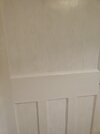Have a 1930s ish house with original wooden doors.
Stripped one of them previously. Didn't do it that thoroughly - light wet sand at the end only - because I'm sure there is lead based paint there and I was worried about making dust. There was definitely some old varnish left at the end. I repainted with a cheap primer then dulux satinwood.
As you can see from the photo, either the old varnish is leeching through, or possibly sap from the wood? Think the doors are pitch pine.
Have one door which is going off to be stripped properly, and want to put some more paint on this one to cover it up.
Can anyone advise on a suitable product, ideally a primer to stop this coming through again? Ideally something available at B&Q or screwfix...
Thanks,
Stripped one of them previously. Didn't do it that thoroughly - light wet sand at the end only - because I'm sure there is lead based paint there and I was worried about making dust. There was definitely some old varnish left at the end. I repainted with a cheap primer then dulux satinwood.
As you can see from the photo, either the old varnish is leeching through, or possibly sap from the wood? Think the doors are pitch pine.
Have one door which is going off to be stripped properly, and want to put some more paint on this one to cover it up.
Can anyone advise on a suitable product, ideally a primer to stop this coming through again? Ideally something available at B&Q or screwfix...
Thanks,


